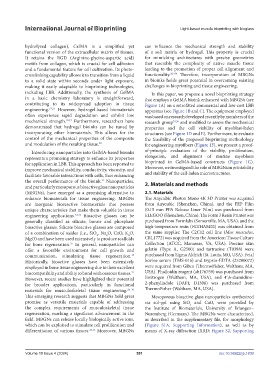Page 559 - IJB-10-4
P. 559
International Journal of Bioprinting Light-based muscle bioprinting with bioglass
hydrolyzed collagen), GelMA is a simplified yet can influence the mechanical strength and stability
functional version of the extracellular matrix of tissues. of a soft matrix or hydrogel. This property is crucial
It retains the RGD (Arginine-glycine-aspartic acid) for mimicking architectures with precise geometries
motifs from collagen, which is crucial for cell adhesion that resemble the complexity of native muscle tissue
and a fundamental feature for cell cultivation. Its photo- leading to the promotion of proper cell alignment and
crosslinking capability allows it to transition from a liquid functionality. 32–34 Therefore, incorporation of MBGNs
to a solid state within seconds under light exposure, in bioinks holds great potential in overcoming existing
making it easily adaptable to bioprinting technologies, challenges in bioprinting and tissue engineering.
including LBB. Additionally, the synthesis of GelMA In this paper, we propose a novel bioprinting strategy
in a basic chemistry laboratory is straightforward, that employs a GelMA bioink enhanced with MBGNs (see
contributing to its widespread adoption in tissue Figure 1A) on a retrofitted commercial and low-cost LBB
engineering. 17,21 However, hydrogel-based biomaterials apparatus (see Figure 1B and C). The equipment employed
often experience rapid degradation and exhibit low was based on research developed recently by members of the
mechanical strength. 18,19 Furthermore, researchers have research group 35,36 and modified to assess the mechanical
demonstrated that hydrogel bioinks can be tuned by properties and the cell viability of myoblast-laden
incorporating other biomaterials. This allows for the structures (see Figure 1D and E). Furthermore, to evaluate
control of the mechanical properties of the composite the feasibility of the proposed bioprinting methodology
and modulation of the resulting tissue. 20 for engineering myofibers (Figure 1F), we present a proof-
Introducing nanoparticles into GelMA-based bioinks of-principle evaluation of the viability, proliferation,
represents a promising strategy to enhance its properties elongation, and alignment of murine myoblasts
for application in LBB. This approach has been reported to bioprinted in GelMA-based constructs (Figure 1G).
improve mechanical stability, conductivity, viscosity, and Moreover, we investigated the role of MBGNs in printability
facilitate favorable interactions with cells, thus enhancing and stability of the cell-laden microstructures.
the overall performance of the bioink. Nanoparticles,
22
and particularly mesoporous bioactive glass nanoparticles 2. Materials and methods
(MBGNs), have emerged as a promising alternative to 2.1. Materials
enhance biomaterials for tissue engineering. MBGNs The Anycubic Photon Mono 4K 3D Printer was acquired
are inorganic bioreactive biomaterials that possess from Anycubic (Shenzhen, China), and the FEP Film
unique characteristics that make them valuable in tissue (0.15 mm PFA Release Liner Film) was purchased from
engineering applications. 23,24 Bioactive glasses can be ELEGOO (Shenzhen, China). The Form 3 Resin Printer was
generally classified as silicate, borate and phosphate purchased from Formlabs (Somerville, MA, USA), and the
bioactive glasses. Silicate bioactive glasses are composed high-temperature resin (FLTHAM02) was obtained from
of a combination of oxides (i.e., SiO , Na O, CaO, K O, the same supplier. The C2C12 cell line (Mus musculus,
2
2
2
MgO) and have been used extensively to produce scaffolds CRL1772) was acquired from the American Tissue Culture
for bone regeneration. In general, nanoparticles can Collection (ATCC, Manassas, VA, USA). Porcine skin
25
offer a favorable environment for cell growth and gelatin (Type A, G2500) and tartrazine (T0388) were
communication, stimulating tissue regeneration. purchased from Sigma Aldrich (St. Louis, MO, USA). Fetal
26
Historically, bioactive glasses have been extensively bovine serum (TMS-016) and trypsin-EDTA (25200072)
employed in bone tissue engineering due to their excellent were acquired from Gibco (ThermoFisher, Waltham, MA,
biocompatibility and ability to bond with osseous tissues. USA). Phalloidin reagent (ab176759) was purchased from
27
However, recent studies have highlighted their potential Invitrogen (Waltham, MA, USA), and 4ʹ,6-diamidino-
for broader applications, particularly in functional 2-phenylindole (DAPI; D1306) was purchased from
materials for musculoskeletal tissue engineering. 28–30 ThermoFisher (Waltham, MA, USA).
This emerging research suggests that MBGNs hold great Mesoporous bioactive glass nanoparticles synthesized
promise as versatile materials capable of addressing via sol–gel using SiO and CaO, were provided by
2
the complex requirements of musculoskeletal tissue the Institute of Biomaterials, University of Erlangen–
regeneration, marking a significant advancement in the Nuremberg (Germany). The MBGNs were characterized,
field. MBGNs can release locally biologically active ions, as described in the supplementary file, for morphology
which can be exploited to stimulate cell proliferation and (Figure S1A, Supporting Information), as well as by
differentiation of various tissues. 25,31 Moreover, MBGNs means of X-ray diffraction (XRD; Figure S2, Supporting
Volume 10 Issue 4 (2024) 551 doi: 10.36922/ijb.1830

